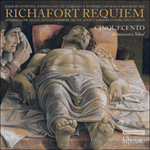The ‘Circumdederunt’ plainsong was at one time thought of as ‘a favourite cantus firmus of Josquin’s’ (Gustave Reese,
Music in the Renaissance), due to its being used in three compositions attributed to him. Two of these—like so many works—have now been convincingly removed from the Josquin canon, leaving only
Nymphes, nappés as an authentic work incorporating this melody. Richafort’s debt to Josquin becomes clear from the seventeenth breve onwards, where the cantus firmus enters, followed three breves later—just as in the Requiem—by its accompanying voice at the upper fifth. Indeed John Milsom, who demonstrated the inauthenticity of the other two pieces, pointed out that Richafort quotes not only the canonic cantus firmus, but also several bars of polyphony from
Nymphes, nappés in the Introit and Kyrie of the Requiem. Its counterpoint is highly suitable for such treatment, being full of the static harmony, twisting melodic lines, and falling third intervals which are characteristic of Josquin’s style in mournful pieces of this type.
from notes by Stephen Rice © 2012
Le plain-chant «Circumdederunt» passa, à une époque, pour «l’un des cantus firmus préférés de Josquin» (Gustave Reese,
Music in the Renaissance), et pour cause: on le retrouvait dans trois compositions qui lui étaient attribuées, même si, depuis, deux d’entre elles ont été—comme tant d’autres—retirées du canon josquinien,
Nymphes, nappés restant la seule pièce authentique à incorporer cette mélodie. La dette de Richafort envers Josquin devient évidente à partir de la dix-septième brève, avec l’entrée du cantus firmus suivi, trois brèves plus tard—exactement comme dans le Requiem—, par sa voix accompagnante à la quinte supérieure. De fait, comme l’a souligné John Milsom, qui démontra l’inauthenticité des deux autres pièces, l’introït et le Kyrie du Requiem de Richafort citent non seulement le cantus firmus canonique, mais aussi plusieurs mesures polyphoniques de
Nymphes, nappés. Son contrepoint se prête admirablement à pareil traitement, avec son harmonie statique, ses lignes mélodiques enroulées et ses intervalles de tierce descendante, typiques du style josquinien dans ce genre de pièces mélancoliques.
extrait des notes rédigées par Stephen Rice © 2012
Français: Hypérion
Man dachte einst, dass der „Circumdederunt“-Cantus „ein von Josquin besonders geschätzter Cantus firmus“ (Gustave Reese,
Music in the Renaissance) sei—der Grund für diese Annahme war, dass er in drei ihm zugeschriebenen Kompositionen verarbeitet ist. Inzwischen jedoch sind zwei davon—wie so viele Werke—überzeugend aus dem Josquin’schen Oeuvre gestrichen worden, so dass nur noch
Nymphes, nappés als authentisches Werk mit dieser Melodie übrigbleibt. Richaforts Verpflichtung gegenüber Josquin wird ab der 17. Brevis deutlich, wo der Cantus firmus einsetzt und sich drei Breven später—ebenso wie im Requiem—die Begleitstimme eine Quinte darüber dazugesellt. John Milsom, der demonstriert hat, dass die anderen beiden Stücke nicht authentisch sind, hat außerdem darauf hingewiesen, dass Richafort nicht nur den kanonischen Cantus firmus zitiert, sondern auch mehrere polyphone Takte aus
Nymphes, nappés, die im Introitus und Kyrie des Requiems erklingen. Der darin enthaltene Kontrapunkt eignet sich besonders gut für eine solche Behandlung, da er voller statischer Harmonie, sich windenden melodischen Linien und fallenden Terzen ist, die für Josquins Stil in derartigen trauervollen Werken charakteristisch sind.
aus dem Begleittext von Stephen Rice © 2012
Deutsch: Viola Scheffel



 Richafort: Requiem & other sacred music
Richafort: Requiem & other sacred music
